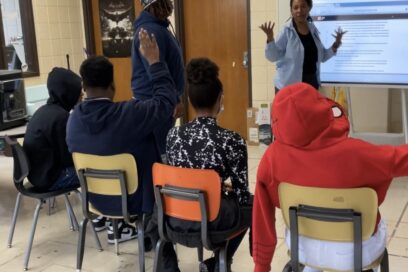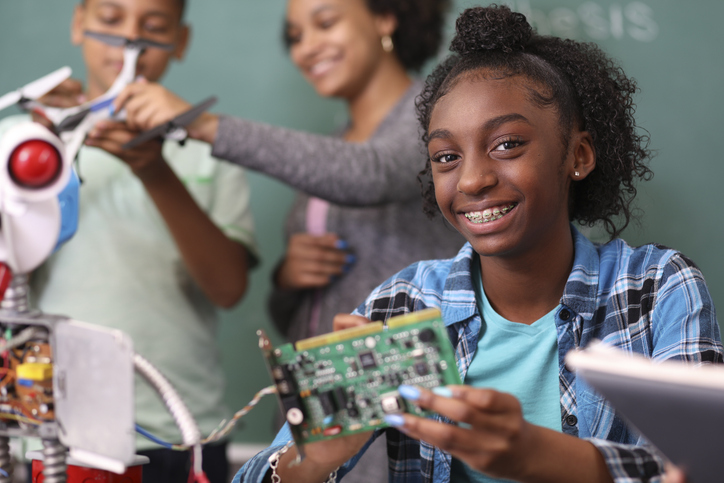As an educator, I truly believe we must redefine and reimagine what we mean by STEM education — especially inclusivity in STEM. Teaching STEM subjects — science, technology, engineering, and math — is frequently misunderstood by administrators, students, and even other teachers. Too often, STEM teachers are expected to explain theoretical concepts but not implement them. Incentives may be structured to encourage teaching to the test rather than devising solutions, but that’s not what STEM is all about.
In the real world, STEM touches our everyday lives. STEM is in everything. Here in Jackson, Miss., our community faces many ongoing problems — and STEM skills and STEM thinking will be needed to solve them. Infrastructure problems? STEM’s the solution. Problems with water supply? STEM solves that. Problems with food? Solve them with STEM.
When students begin to see that STEM can be part of solving problems that they and their families face every day, that’s when we are able to truly engage them in learning.

Start with problem-based learning
The good news is that problem-based learning, inquiry-based learning and other hands-on education approaches are gaining widespread acceptance in STEM education circles as antidotes to rote memorization and a focus on standardized testing that fail to engage students.
But it’s important for me as a person of color, and for my students, to highlight that problem-solving approaches aren’t new to education. A legacy too often forgotten is that Black educators have long been among the leading proponents of using PBL and STEM disciplines as a core of education, and its important to have inclusivity in STEM today.
My heroes George Washington Carver and Booker T. Washington were STEM evangelists starting back in the 19th and early 20th centuries. Tuskegee Institute and later historically black colleges and universities have STEM education at their cores. These institutions are designed for practical problem-solving, addressing real-world issues that resonate within the Black American community. This approach encompasses a broad spectrum, including mechanics, agriculture and engineering, reflecting a commitment to addressing the pressing challenges that matter in the lived experiences of Black Americans. Creating real-world solutions needs to be recognized as a vibrant and vital part of the fuller STEM universe, as much as any pursuit of theoretical physics.
Competitions spark students’ creativity
I’ve found that a great way for teachers to explore the educational possibilities of problem-solving — to get classes engaged in STEM — is by entering some of the popular national STEM competitions. Some of my students from Jackson gained national recognition for two Solve for Tomorrow STEM competition projects: One addressed Jackson’s clean water crisis, while the other tackled food insecurity in our community during the pandemic. These efforts respectively earned us state winner and national finalist accolades. This year, my students are working on combating urban heat islands fueled by global warming, designing a bike/walking path to eliminate pollution from burning fossil fuel in buses that shuttle kids between buildings on our campus.
The payoff for students who get engaged with hands-on experience in STEM goes well beyond academics. It can be life-changing. One student who worked on a project involving building and flying drones went on to become a certified drone pilot and later got his own aircraft pilot’s license. That’s a thrilling accomplishment for a high-school youth in a disadvantaged community, and it opens doors to future possibilities for him. And inclusivity in STEM helped it happen.
It’s quite a change from attitudes that persisted even when I was growing up. As a young girl raised in Mississippi, I told a favorite teacher that my dream was to work for Disney. “Ms. Wallace,” he cautioned, “Black people don’t work at Disney.”
Coming from a family of educators I recognized that this respected Black man was giving me advice born of generations of finding our path in society where the deck was stacked against us. Once I was an adult, I recognized he was only preparing me for obstacles and discrimination that I would face. Thankfully, I found ways around my obstacles — and it’s my mission to do the same for younger generations of marginalized students. It’s why I practice, and preach, inclusivity in STEM classrooms.
3 ways to enhance inclusivity in STEM classrooms
- Define STEM as a PBL approach to solving real-world challenges. STEM is everything. It’s not memorizing academic subjects for testing. STEM is encouraging students to employ a full range of skills in hands-on ways. Before I returned to Jackson to teach, I studied photography and design and worked as a user experience and game designer. I bring all that to my STEM classes.
- Help students find a real-world, local issue in their community that needs fixing. This is a vital part of inclusivity in STEM, as it will show them there is real value in what they can visualize and create, and it will ensure that students are truly engaged. It’s important that the students be involved in identifying the problems to solve rather than just being handed an assignment. Involve them in brainstorming with classmates, and encourage them to seek input from their community, starting with family and friends. Help them reach out to local officials and agencies for input on their solutions.
- Representation matters. Inclusivity in STEM also means ensuring students can see people who look like themselves in positions of trust and authority, because that helps them more readily visualize their own career opportunities. I was fortunate to have the examples of my own mother, who is a teacher, and other Black American teachers to follow, as well as Dr. Carver and Dr. Washington.
While my background is in design and development, I know that history can teach us important lessons — especially the forgotten or overlooked elements of the Black experience in America. It’s one reason I keep reminding my students that we stand on the shoulders of those who came before us — not just the Carvers and Washingtons, but others like Benjamin Banneker, Garrett Morgan, Katherine Johnson, Dorothy Vaughan, Mary Jackson and many more.
Coming back home to Mississippi, after studying design in Savannah, Ga., and working in web and game design in Atlanta, I’m energized by helping next-gen learners of color advance toward their dreams. And I honor my own dream as I look in the mirror and belt out my favorite Disney song, “Reflection from Mulan.”
Opinions expressed by SmartBrief contributors are their own.
_________________________
Subscribe to SmartBrief’s FREE email newsletter to see the latest hot topics on edtech. It’s among SmartBrief’s more than 250 industry-focused newsletters.
